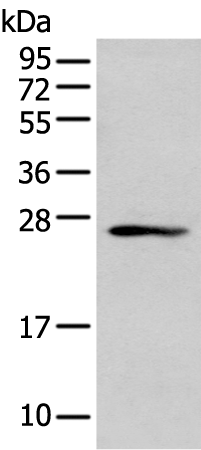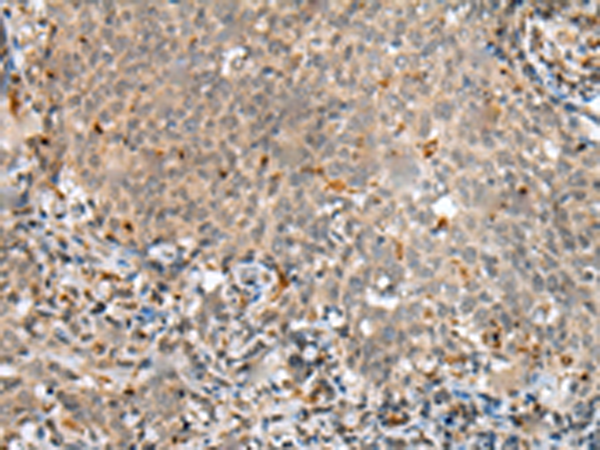

| WB | 咨询技术 | Human,Mouse,Rat |
| IF | 咨询技术 | Human,Mouse,Rat |
| IHC | 1/25-1/100 | Human,Mouse,Rat |
| ICC | 技术咨询 | Human,Mouse,Rat |
| FCM | 咨询技术 | Human,Mouse,Rat |
| Elisa | 1/5000-1/10000 | Human,Mouse,Rat |
| WB Predicted band size | 32 kDa |
| Host/Isotype | Rabbit IgG |
| Antibody Type | Primary antibody |
| Storage | Store at 4°C short term. Aliquot and store at -20°C long term. Avoid freeze/thaw cycles. |
| Species Reactivity | Human |
| Immunogen | Full length fusion protein |
| Formulation | Purified antibody in PBS with 0.05% sodium azide and 50% glycerol. |
+ +
以下是关于ASB9抗体的3篇参考文献,包含文献名称、作者及简要摘要内容:
---
1. **文献名称**:*ASB9 interacts with ubiquitous mitochondrial creatine kinase and inhibits apoptosis*
**作者**:Kohroki J, Fujita S, Itoh N, et al.
**摘要**:该研究揭示了ASB9通过其SOCS盒结构域与Elongin B/C泛素连接酶复合体结合,并发现ASB9抗体在实验中用于检测其与线粒体肌酸激酶(uMtCK)的相互作用,表明ASB9可能通过调控uMtCK稳定性影响细胞凋亡。
---
2. **文献名称**:*The role of ASB9 in renal cell carcinoma progression*
**作者**:Huang J, Chen Y, Li J, et al.
**摘要**:研究利用ASB9抗体进行免疫组化分析,发现ASB9在肾细胞癌组织中表达显著上调,且与肿瘤分级和转移相关,提示ASB9可能作为癌症进展的潜在生物标志物。
---
3. **文献名称**:*ASB9 regulates β-catenin signaling via ubiquitination in glioblastoma*
**作者**:Schmidt MH, Dikic I, Böhmer FD.
**摘要**:通过ASB9抗体的Western blot和免疫共沉淀实验,研究发现ASB9通过泛素化修饰β-catenin,抑制Wnt信号通路活性,从而影响胶质母细胞瘤细胞的增殖和侵袭能力。
---
这些研究均利用ASB9抗体进行蛋白互作、表达分析或功能机制探索,涵盖了癌症、细胞凋亡及信号通路调控等领域。如需具体文献来源,建议通过PubMed或期刊官网检索标题及作者以获取全文。
The Ankyrin repeat and SOCS box protein 9 (ASB9) is a member of the ASB family, characterized by an N-terminal ankyrin repeat domain and a C-terminal SOCS box motif. It functions as a substrate-recognition component within E3 ubiquitin ligase complexes, targeting specific proteins for ubiquitination and subsequent proteasomal degradation. ASB9 is notably involved in regulating cellular processes such as cell cycle progression, signal transduction, and energy metabolism. Studies have shown that ASB9 interacts with mitochondrial creatine kinase (MtCK), modulating its stability and activity, which links ASB9 to ATP regeneration and cellular energy homeostasis. Dysregulation of ASB9 has been implicated in cancer, with altered expression observed in renal cell carcinoma, glioblastoma, and other malignancies, suggesting its potential role in tumorigenesis or tumor suppression depending on context.
ASB9 antibodies are essential tools for investigating its expression, localization, and molecular interactions. They enable detection of endogenous ASB9 via techniques like Western blotting, immunohistochemistry, and immunofluorescence. Researchers also use these antibodies for co-immunoprecipitation to identify binding partners, such as MtCK or components of the ubiquitination machinery. Commercial ASB9 antibodies are typically validated for specificity and sensitivity across human, mouse, and rat samples. Their applications extend to studying ASB9's involvement in diseases, including cancer metabolism and neurological disorders, providing insights into therapeutic targeting of ubiquitin-proteasome pathways. Ongoing research aims to clarify ASB9's dual roles in cellular regulation and pathology, emphasizing its context-dependent functions.
×